
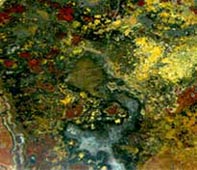
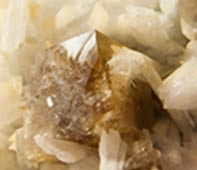
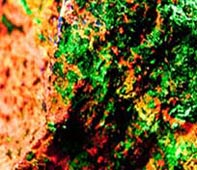
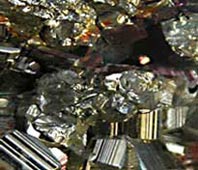
Phosphorescing Diamond
by Smiley Rock
From: The Pick and Dop Stick, 9/2013
2nd Place — 2014 AFMS Junior Articles Under 12
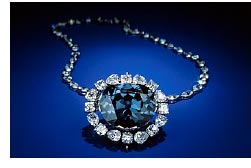
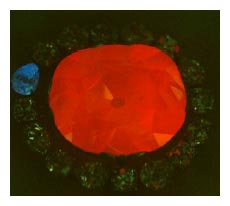
The Hope Diamond emits a red
phosphorescence after being
bombarded with ultraviolet light.
(Photo by John Nels Hatleberg)
The diamond is one of the greatest minerals ever discovered. One very unique diamond is the Hope Diamond. The Hope Diamond has a long past because it was passed down and sold so many times. A diamond is a hard form of carbon that is valued as a precious gem and it is used for jewelry, and as a cutting tool blade.
The Hope Diamond weighs 45.52 carats, and its length is 25.60 mm. Its width is 21.78 mm and its depth is 12.00 mm. The Hope Diamond is a fancy, dark, grayishblue color and it is in a pendant with 16 diamonds around it and 45 diamonds on the chain. Evalyn Mclean had the diamond so she asked the merchants to make it into a pendant. The clarity of the Hope Diamond is slightly affected by whitish graining. The Hope Diamond phosphoresces red when exposed to short wave UV lights. Phosphorescing is the process of an object glowing after being exposed to radiation. Because the diamond is so beautiful, it has a very lengthy history.
The Hope Diamond was found in a mine in Golcona, India called the Kollur mine. It was purchased by Jean Baptiste Tavernier who was a French merchant. The diamond Tavernier purchased was 112 - 3/16 carats. Later in 1668, Tavernier sold the diamond to King Louis the XIV of France. In 1673, the king requested that the diamond be re-cut and put on his neck ribbon that he wore to special occasions. Because of the diamond 's blue color, it was called Blue Diamond of the Crown. While the people were rebelling against the government, the diamond was stolen in September of 1792 during a week long looting of the crown jewels. A London merchant named Daniel Eliason obtained possession of the diamond in 1812. Then Daniel sold the diamond to King George the IV of England. Then King George the IV sold the diamond through private channels.
In 1839, it was discovered that Henry Philip Hope had the diamond. Henry Hope was a banker and a famous gem collector. After Henry Philip Hope died in 1839, the diamond was given to his nephew Henry Thomas Hope and then to his grandson Lord Francis Hope. Lord Francis Hope sold the diamond in 1901 to pay off his debt. The Hope Diamond was named after the Hope family, so the Hope family was a huge part of the Hope Diamond 's history. Since 1901, the Hope Diamond was sold around to seven different people. Pierre Cartier cut the diamond and made it into a pendant. In 1958, the Hope Diamond was donated to the Smithsonian Institution by Harry Winston Inc.
The Hope Diamond's current location is in the Smithsonian Institute and has been loaned out 4 times. Many people go to the Smithsonian to see the Hope Diamond. The Hope Diamond lies on a rotating platform that shows every angle of the diamond.
The beauty of the Hope Diamond has drawn many people to the Smithsonian to see it, where it sits up front in the museum, making people want to see the rest of the collection. The Hope diamond 's unique characteristics are easy to recognize even though so many people owned and cut it. The Hope Diamond is beautiful and has a phenomenal history as a remarkable mineral.
Bibliography:
1. "The Hope Diamond", Prepared by the Department of Mineral Sciences.
http://www.si.edu/Encyclopedia_SI/nmnh/hope.htm
2. Small, Lawrence. "The Hope Diamond", April 2000. Smithsonian Magazine. http://www.smithsonianmag.com/travel/small_apr00.html
3. Diamond Definition. http://dictionary.reference.com/browse/Diamond
4. http://smithsonianscience.org/2009/08/blue-hope-diamond-glows-an-erie-red-after-exposure-to-ultraviolet-light/
For permission to reprint this article, contact us at info@chicagorocks.org.
